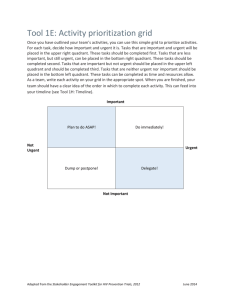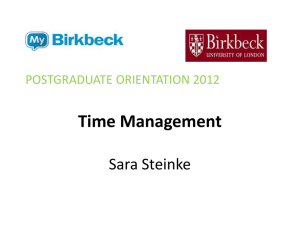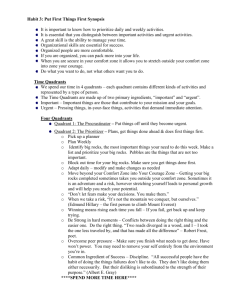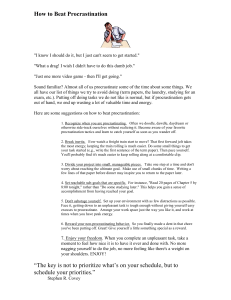9 TIME MANAGEMENT
advertisement
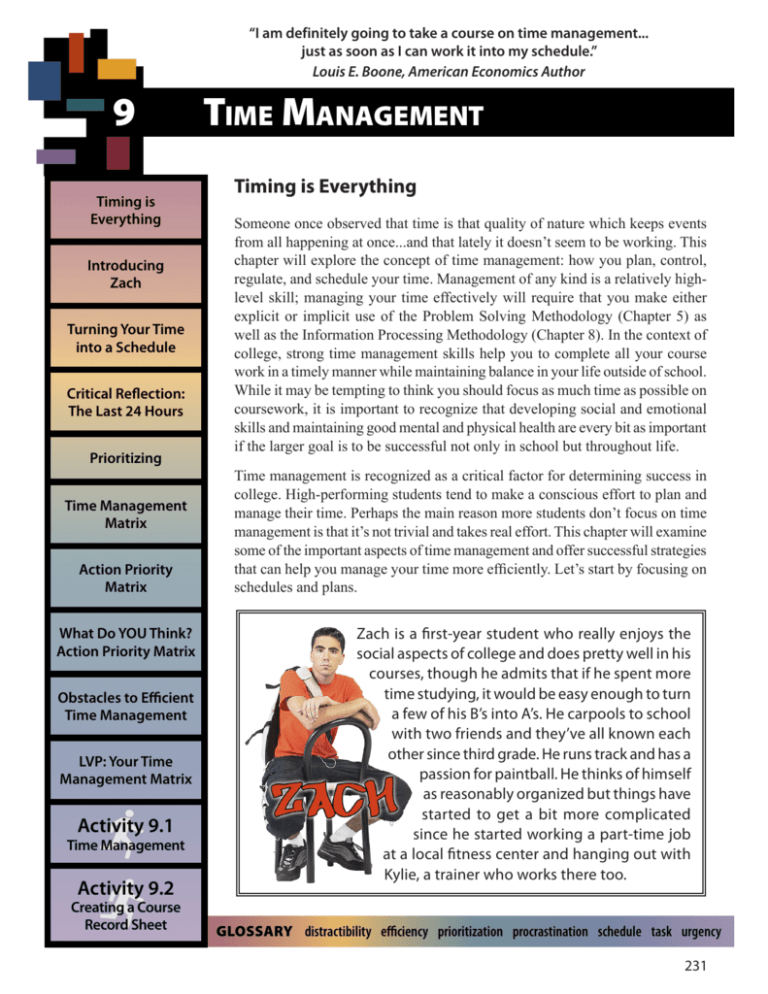
“I am definitely going to take a course on time management... just as soon as I can work it into my schedule.” Louis E. Boone, American Economics Author 9 Time Management Timing is Everything Timing is Everything Someone once observed that time is that quality of nature which keeps events from all happening at once...and that lately it doesn’t seem to be working. This chapter will explore the concept of time management: how you plan, control, regulate, and schedule your time. Management of any kind is a relatively highlevel skill; managing your time effectively will require that you make either explicit or implicit use of the Problem Solving Methodology (Chapter 5) as well as the Information Processing Methodology (Chapter 8). In the context of college, strong time management skills help you to complete all your course work in a timely manner while maintaining balance in your life outside of school. While it may be tempting to think you should focus as much time as possible on coursework, it is important to recognize that developing social and emotional skills and maintaining good mental and physical health are every bit as important if the larger goal is to be successful not only in school but throughout life. Introducing Zach Turning Your Time into a Schedule Critical Reflection: The Last 24 Hours Prioritizing Time management is recognized as a critical factor for determining success in college. High-performing students tend to make a conscious effort to plan and manage their time. Perhaps the main reason more students don’t focus on time management is that it’s not trivial and takes real effort. This chapter will examine some of the important aspects of time management and offer successful strategies that can help you manage your time more efficiently. Let’s start by focusing on schedules and plans. Time Management Matrix Action Priority Matrix Zach is a first-year student who really enjoys the social aspects of college and does pretty well in his courses, though he admits that if he spent more time studying, it would be easy enough to turn a few of his B’s into A’s. He carpools to school with two friends and they’ve all known each other since third grade. He runs track and has a passion for paintball. He thinks of himself as reasonably organized but things have started to get a bit more complicated since he started working a part-time job at a local fitness center and hanging out with Kylie, a trainer who works there too. What Do YOU Think? Action Priority Matrix Obstacles to Efficient Time Management LVP: Your Time Management Matrix Activity 9.1 Time Management Activity 9.2 Creating a Course Record Sheet Glossary distractibility efficiency prioritization procrastination schedule task urgency 231 Learning Objectives At the end of this chapter, you should be able to: • Think critically about time management • Create an efficient weekly schedule • Create prioritized task lists • Prioritize based upon the criteria of importance, urgency, effort, and impact Reading Turning Your Time into a Schedule The first step in time management is to become aware of how you are currently spending your time. Once this determination is made, regardless of your current situation, you can take action to make improvements. A good tool to monitor your time is a day-planner that breaks down each day into certain time increments. Day-planners are readily available in bookstores or you can easily create your own day-planner. Monday Task Time Getting ready for day 7:00-8:00 am 1 hour Personal Maintenance Check e-mail & web 8:00-8:30 am 30 mins Online time Breakfast 8:30-9:00 am 30 mins Meals 9:30-10:00 am 30 mins Driving/Riding Drive to school Duration Category Be diligent in recording your activities throughout the period of a week. Break down how you spend your time into various categories (such as in-class time, studying, sleeping, eating, time with friends, recreation, e-mail and Internet, television, travel, etc.). Don’t be too general in your use of time category headings. Be sure to identify any ‘missing time’ in your records. In the example above, there were 30 minutes between finishing breakfast and starting the drive to school. How did you spend those 30 minutes? Did you watch TV? Did you spend it looking for your keys? Account for all the time you possibly can. Don’t judge that time at this stage; simply account for it. At the end of a week, sum the totals in the various time categories. Analyze the time data you collected. 232 Foundations of Learning Critical Reflection The Last 24 Hours Activity 9.1 will give you the opportunity to formally complete this kind of time analysis for a week’s worth of time spent. For now however, consider the last 24 hours. Into what categories do your major commitments, activities, and tasks over this period fit? Do your categories suggest any kind of pattern or trend? Zach’s last 24 hours: Yesterday was a crazy day. I worked in the morning and only had one afternoon class, so I need categories like work and in-class. But on the way home from work, I stopped by the mall to pick up a new cell phone and while I was there, I ran into an old friend. After talking for about an hour, I had to rush home and grab my bio homework to turn in. When class was over, I had to swing BACK by work (I forgot to return a DVD I borrowed from Kylie), went home (again) and read some of my history assignment, then met my buddies for pool and wings. It was midnight by the time I got home and after some sleep and a quick shower, here I am again. So the other categories I used were necessary errands, errands because I didn’t plan ahead (there were too many of those), hanging with friends, meals, and studying. Yeah, I see a pattern—I did a lot more driving around than I really had time for, and all because I forgot things or didn’t plan very well. Chapter 9 — Time Management 233 Creating a More Efficient and Focused Schedule The best way to give your schedule an efficiency makeover is to begin with fixed commitments, study time, and then all other commitments. Using a blank day-planner, initially fill in only those items which are fixed commitments (sleep, courses, work, travel time, meals, etc). These are the tasks which absolutely must be done and, with some variation for your course schedule, these time blocks won’t move around much from week to week. Be sure to review the record you made of a full week’s worth of activities, actions, commitments, and tasks as you fill in the new planner, creating your new schedule. Once you have accounted for the committed times, you should begin to see patterns or blocks of available time. Though time for studying is not usually fixed (an exception might be scheduled study groups), if you have committed to your own success in school, then reserving time for studying is a top priority. A general guideline for out-of-class study time is that for every hour spent in the classroom, you should spend two hours studying out of the classroom. For more challenging courses, you should allocate three or more hours outside of class for every classroom hour. Another factor that influences study time in a course is your skill set compared to the demands of a particular course. For example, if you are a slow reader taking a history or literature course, you should adjust your study time accordingly. Keep track of the time you spend studying for each course. Record how long it takes you to complete problem sets, to read chapters in particular textbooks, etc. This information can be used to help you revise and adjust the study time aspect of your management plan. When considering allocating or designating study times, consider times when you are physically and emotionally ready to study and perform at a high level. Try to match the times of the day when you are sharpest with times you can study. Also, realize that for many people, it is more effective to study in one-hour blocks of time than to study for three or four hours at a time. If you do study for longer periods of time, be sure to take periodic breaks. With your committed time and study time allocated, fill in the rest of your plan with other activities based on how you usually spend your time. Creating a workable and efficient schedule is somewhat like filling a large jar. Think of your important commitments as large stones. Put them in the jar first. Then add pebbles (smaller tasks and less critical activities), which will fill the spaces between the stones. Finally, finish by adding sand (the small and quick tasks which can be done nearly anytime), which fills the space between the pebbles. Not only is there room for more than you might imagine, if you don’t put the big stones in first, you’ll never get them in at all. Proceed to Activity 9.1 (page 245) Prioritizing: Making the Best Use of Your Time “Things which matter most must never be at the mercy of things that matter least.” Johann Wolfgang von Goethe Your time is finite (there are only 24 hours in a day, after all) and finding a way to work in all the things you need and want to do can be a challenge. Add deadlines to this and it becomes even more complicated. This is why people who manage their time wisely focus on deciding what tasks or projects should be scheduled, done first, or given a higher degree of importance when scheduling their time. Assigning relative importance or priority is called prioritizing. 234 Foundations of Learning For example, Zach blocked out two hours of “Study Time” on Wednesday night, but he has a mid-term exam in a class on Thursday, needs to create a draft outline for a paper which is due next week, and has to get a new tire for his car because of the flat he got this afternoon. On top of all this, he’s been asked to stay an hour later at work to attend a meeting on Wednesday night AND he promised to quiz Kylie on her French vocabulary to help her prepare for her exam on Friday. Zach thinks of himself as a fairly efficient scheduler but he admits this is a lot to juggle. His situation is fairly representative of the kinds of prioritizing and scheduling problems that you will deal with not only while in college, but also throughout the rest of your professional, post-school life as well. Given that, how do you choose which task should be highest priority? One mistake that people often make is confusing things which are important with things which are interesting. We tend to naturally fix our attention on things that interest us and that includes animated figures and catchy music or sound. That’s why cartoons, videos, movies, and television are all so popular. They ARE interesting. But are they important? Similarly, meeting friends for pizza and a movie is very interesting—it completely captivates our attention. But is it important? And what about learning to create a list of sources or how to use the Pythagorean Theorem? Is it interesting? Is it important? No one but you can decide what is important in your life but assuming that your goals are important to you (and why else would you have them?), then any task or time spent which helps you get closer to achieving your goals must be important. You’ve already had some good experience with prioritizing; the Personal Development Methodology made explicit use of prioritizing based on values. The fact that you’re in college means that you decided that your time is better spent learning and preparing for a profession than many other alternatives. And when you filled in your weekly schedule, once fixed commitments were allocated (the highest priorities), the next priority was study time. If you stop and think about it, you actually decide priorities all the time, often without really being aware that’s what you’re doing. Part of the point of practicing time management is to elevate some of these nearly unconscious decisions to the level of conscious choices, made with deliberation and forethought. There are many good tools and techniques to help you prioritize tasks; each has the potential to help you manage your time even more efficiently. ABC List An ABC list is an easy way to prioritize a list of tasks. An ABC list works best as a kind of daily “to-do” list where each item is assigned a category: A for MUST be done, B for SHOULD be done, and C for COULD be done. Though this sounds simple, it is a very effective way to keep you focused upon completing tasks that are most important. When you are busy or dreading a particular task, it is sometimes difficult to decide what ought to be done first and what can wait until later. For this reason, it is best to create an ABC task list each morning and revisit and revise it as you move through your day, taking care of “A” items, then “B” items, and finally any “C” items you have time left for. Some people find it helpful to assign an estimation of the time each task will take, allowing them to be more aware of how much time is spent on each type of task. A variation of the ABC list is a task list where each item is assigned a priority rating from 1 to 5, where 1’s are the highest priority and 5’s are the lowest. There is no right or wrong way to list priorities; the real trick is not in whether you use numbers or letters, but in deciding how to prioritize competing tasks in the first place and then using your list to guide where you direct your time and energy. Chapter 9 — Time Management 235 Time Management Matrix: Importance and Urgency President Dwight D. Eisenhower said, “Most things which are urgent are not important, and most things which are important are not urgent.” He is known to have made use of a matrix which is now sometimes called the Eisenhower Matrix or Importance-Urgency Matrix. Author and professional speaker Stephen Covey included a revised version of the matrix in his best-selling book, The Seven Habits of Highly Effective People, shining a well-deserved spotlight on this useful analytical tool. We have already considered the trap of confusing what is interesting with what is important. Given the sense of urgency that pervades so much of modern life, where messages, as well as coffee are “instant,” another and perhaps more pernicious trap is: confusing what is important with that which is merely urgent. Covey writes, It’s important to realize that urgency itself is not the problem. The problem is that when urgency is the dominant factor in our lives, importance isn’t. What we regard as ‘first things’ are urgent things. We’re so caught up in doing, we don’t even stop to ask if what we’re doing really needs to be done. Important Urgent NOT Important Time Management Matrix The Time Management Matrix (shown below) can help you focus your time and energy on what’s most important and avoid those activities that are less important or not important to you. While that’s a great strategy for making decisions about prioritizing concrete tasks, it is an invaluable guide for the much larger issue of realizing the life goals you have and will set for yourself. I stress NOT Urgent II value crises education pressing problems preparation deadline-driven projects relationship-building III deception new opportunities IV regret popular activities trivia some communication timewasters most interruptions Let’s examine the individual quadrants of the Time Management Matrix: Quadrant I: Urgent and Important These tasks or activities must be done immediately and they are important; they also tend to cause stress. Ignoring activities in this quadrant can cause problems that range from serious (jeopardizing your life goals) to life-threatening. 236 Foundations of Learning Examples: an engine warning light on the dashboard of your car, dangerously high blood pressure, an emotionally or physically abusive relationship, writing the final paragraph of your term paper (which is due tomorrow), etc. Strategy: Deal with it NOW! Quadrant II: NOT Urgent but Important These tasks or activities which need not be done immediately, but are important to you and your life goals—they lead to value in your life. Because the benefit for time spent on these activities tends to be long-term, it is easy to ignore them and think that you’ll get to them eventually. But in order to attain the value linked to these activities, you must plan and commit both the time and effort the activities require. Examples: your college education, friendships, physical exercise, working on your life vision Strategy: Pare down the other quadrants (I, III, and IV) by expanding this one. This will lead to a rich life of rewarding and value-laden experiences. Covey expresses it as, “the key is not to prioritize your schedule, but to schedule your priorities.” Quadrant III: Urgent but NOT Important These tasks or activities which need to be done or dealt with immediately, but are unimportant to you and your life goals. Because we are attuned to responding to urgency, we tend to deceive ourselves (or others) into believing that urgency itself indicates what is important. It is possible to spend a life dealing with urgent, yet unimportant activities. Examples: some job-related activities (the meeting that accomplishes little), the political pollster ringing your doorbell, the friend who calls to chat when he or she is bored, the ringing phone with a telemarketer on the other end, waiting for the cable repairman to show up, etc. Note that an activity which would otherwise qualify as a Quadrant III activity can be changed to a Quadrant I activity, if you are engaged in the activity because it is important to someone else and they or their judgement are important to you. For instance, participating in that business meeting that doesn’t accomplish much can be a Quadrant I activity if your manager wants you to be there and you want to keep your job. The same can be said for many school-related activities such as passing an elective course. That particular course may not be important to you personally, but because it is important to those in charge of granting your degree (which IS important to you), the fact that it is important to them makes it important to you. Strategy: As much as possible, delegate these tasks. If you cannot delegate them, find a way to get out of them or get them done quickly. Quadrant IV: NOT Urgent and NOT Important These are tasks or activities which need not be done immediately (if ever), and are not important to you and your life goals—they are the very definition of wasted time. Time spent on activities in this quadrant is time not spent on either urgent OR important activities and can lead to feelings of regret. Examples: watching mindless TV, playing video games, aimlessly surfing the net, etc. Strategy: Only engage in these activities when everything else is done. Or, better yet, drop them completely. Chapter 9 — Time Management 237 Action Priority Matrix: Impact and Effort Action Priority Matrix The Action Priority Matrix is somewhat similar to the Time Management Matrix, though it is used for a different purpose. Use the Action Priority Matrix to help you decide what type of task is the most rewarding and efficient use of your time, as you strive to meet your goals. The Matrix can also be used as a way to take your time management pulse—to see what kinds of projects or tasks take up the majority of your time. High Quick Wins Major Projects Busy Work Running in Place IMPACT Low Low EFFORT High Impact (the vertical axis) is the degree to which the task will advance your goals. If your goal is earning a high grade on a math test, a high-impact task might be reviewing your graded assignments and practicing any problems where you made mistakes. For the same goal of a high grade on a math test, a low-impact task might include sharpening a couple of extra pencils for use during the test. Or, in the words of Henry David Thoreau, “It’s not enough to be busy, so are the ants. The question is, what are we busy about?” Effort (the horizontal axis) is the amount of time and energy required to accomplish a task. Sharpening pencils is generally a low-effort task (unless you don’t have a pencil sharpener). Creating a table of the types of errors you find yourself making when solving math problems, on the other hand, is a much higher-effort task. Tips for using the Action Priority Matrix: • Create a version of the Matrix that has space in all four squares where you can write down tasks that you need or want to accomplish • Keep your Matrix with you so that you can add tasks as they occur to you • Remember that the Matrix doesn’t tell you what you should do; it is only a tool to help you categorize your activities so that you can decide the most efficient and impactful use of your time. 238 Foundations of Learning What Do YOU Think? Give an example of a task for each of the four categories in the Action Priority Matrix. Use current courses and experiences (i.e., the examples should be real and pertinent to tasks you’re working on or planning now). Zach’s response: Quick Wins: I’m taking a course where a significant part of our grade depends upon our involvement and interaction in online discussions. That’s something that I enjoy and it doesn’t take much effort on my part (I have a laptop and Internet connection at home). Busy Work: My job at the fitness center qualifies as busy work. It doesn’t take a lot of effort and it’s not the kind of work I plan to do professionally. It’s just a job to help me pay for textbooks and gas. Running in Place: OK, I decided to take an accounting class because Kylie was registering for it. Bad idea. I’m a Communications major so the course is an elective and it’s not at all easy for me. I spend more time doing homework for that class than any THREE of my other classes! Major Projects: This will sound a little strange, but I’m actually helping a couple of grad students with a Comm project. We’re interviewing some of the residents of local retirement homes and collecting oral histories from people who remember the city before the highway was built and when Prohibition was in place. Amazing stories! Anyhow, I get some academic credit, but more importantly, it’s the kind of thing I want to do after I graduate. Chapter 9 — Time Management 239 Making it Happen: When you’ve got it planned, how do you get it DONE? There are hundreds of software programs and many hand-held devices that can help you plan and manage your time, create efficient and useful schedules, and prioritize tasks. Some programs are free (try searching for ‘time management programs’ in a search engine) and others are very reasonably priced. Most time management programs allow you to assign priorities, due dates, and categories to task lists, while others integrate calendars and reporting functions. Some people are much more comfortable with a hand-written ‘to-do’ list that they can carry around with them and add or cross off items as needed. You simply need to decide how high a priority managing your time and schedule is and how much time and effort you’re willing to invest in finding or creating a system that will work for you. It can be a valuable and rewarding project or a nice quick win. Avoid using or creating a system that turns time management into busy work or running in place. While the challenges of managing time are similar for students and professionals, there are some additional considerations when trying to manage courses and study time. Because you take different courses (all of which have their own schedules, fixed dates, and deadlines) every term or semester, it makes good sense to organize your time for different time intervals. On a monthly and semester or term basis The Course Record Keeper presented as part of Activity 2 is an ideal tool for staying organized in all of your courses. Use the Course Record Keeper along with a blank monthly calendar (which you fill in) and the syllabus from each course to keep on top of important deadlines and dates associated with your courses. Refer to these tools on a regular basis and update the information accordingly. On a weekly basis Fill in a schedule for the week with committed times, study times, and other uses of your time. On a daily basis To-do lists are helpful for prioritizing tasks on a daily basis. Be sure to Label or categorize the items in order of importance (ABC or 1 through 5). Proceed to Activity 9.2 (page 249) Obstacles to Efficient Time Management Inefficient scheduling Too often we neglect to consider the ‘hidden’ time requirements for tasks and, as a result, we underestimate the time required to complete a task. As an example, you might plan a 10-minute drive to meet a friend, but what if you need to gas up your car? What was a simple 10-minute drive is now a 15 or 20-minute activity. Similarly, we tend to downplay the actual time commitments involved for tasks like studying and writing papers. This is just one reason that identifying the actual amount of time you spend on tasks in a given week is so important; once you know the actual time that 240 Foundations of Learning different tasks require, you can formulate a realistic schedule. Another pitfall for many people is over-scheduling and over-extending themselves. There is often tremendous pressure on individuals to prove that they can “do it all.” No one can. Over-scheduling and over-extending yourself not only leads to decreased performance, but also causes stress, which compromise your physical and mental health. Having a realistic schedule means that you’ll have to say “NO” sometimes. Distractibility It is easy to become distracted when a task is not interesting. Not all tasks will automatically engage you; you must find ways to MAKE tasks interesting—be inventive, create mnemonics, even visualize Pythagoras trying to sell his theorem on an infomercial, if that’s what it takes. In short, do whatever you have to do to help focus your attention on the task or subject at hand. • When it comes to studying, try to limit exposure to possible distractions. • If a situation or problem consistently distracts you, consider shifting focus to that problem long enough to solve it. It is better to allow a single, productive distraction (getting rid of the distraction once and for all) than to allow ongoing or multiple distractions that do nothing more than repeatedly break your concentration. • Many working professionals have found that turning OFF cell phones, e-mail, and instant messaging when trying to get work done allows them to focus better and be more efficient. • Trying to remember various obligations and tasks is a common distractor. You may be reading and find yourself thinking things like, “I’ve got to remember to take my calculator tomorrow” or “I hope I don’t forget to meet my study group at the library instead of the study center.” This is where keeping a daily “to-do” list is a lifesaver. When you create your list for the day in the morning (or the night before), you add all the items you know you will need to accomplish that day. Once the items are on the list, you only need to remember to keep the list with you (one thing) rather than all the items on the list. If additional tasks occur to you, add them to your list immediately so you can get back to focusing on the task at hand. Over-organization Another obstacle to efficient time management is over-organization. This may not sound like a bad thing; after all, how could someone be too organized? But it is a danger, especially for people who enjoy creating and working with systems. If the first item on your daily “to-do” list is, “Create daily to-do list,” the chances are good that you’ve fallen into the over-organization trap. This is only partly in jest; treating time management as a problem in and of itself can lead to spending inordinate amounts of time and effort in planning, scheduling, analyzing, and tweaking your calendar and task and priority lists, leaving little time for the actual tasks themselves. Over-organization is not efficient or effective time management. The goal is to spend enough time creating and then managing your time so that you maximize the impact of that time. Procrastination We’re all guilty of procrastination (putting off a task until later), at some point. Given the choice, we all prefer to spend our time engaged in enjoyable activities rather than those that are difficult or uncomfortable. Wise time managers understand this and rather than letting procrastination become habitual, they consistently work to overcome and avoid it. Chapter 9 — Time Management 241 Procrastination is more than just a personality quirk; it can be very destructive. The longer we procrastinate, the longer the list of things we need to do becomes. As that list grows, it is increasingly tempting to procrastinate. The good news is that there are ways to stop this cycle, even once you’re in it. And doing that is important because this kind of cycle is exceedingly self-destructive and can lead to poor self esteem and even acute feelings of failure and self-hatred. Three of the most common causes of procrastination are discussed in this section, along with suggestions for dealing with them. Fear of failure We think that avoiding a task will somehow keep us from running the risk of failure. After all, if you don’t wear a watch, no one can accuse you of being late, right? It is obvious that this reaction is not rational, but even otherwise successful people are sometimes afraid of failure. The difference is that they cut themselves some slack and go ahead and try. If you are afraid to commit to tasks and projects for fear of failing, there is little hope of managing your time efficiently, because you’re not only working against the clock (or calendar), you’re also working against yourself. • Once you become aware of these tendencies, remind yourself that “failure” is very often just an early stage of success and that everyone starts somewhere (i.e., even Rembrandt colored outside the lines as a child). • Refuse to judge yourself and instead assess your performance, recognizing your strengths and giving yourself credit for each attempt and bit of progress you make. Feeling Overwhelmed Your life is a busy environment where you must juggle multiple requirements and responsibilities. Adding college to that mix virtually guarantees that, at some point, you will feel overwhelmed. One fairly typical reaction to this feeling is to stop trying to keep up with activities and projects—rather than trying and failing, we begin failing to even try. • Consider that you may have truly over-committed yourself, making success impossible. Are there any high-effort low-impact (or urgent but unimportant) items which you can drop? Think “slash and burn” with respect to your priority list, actually removing the items which do not ultimately bring you closer to your life goals. • It is helpful to break larger projects up into smaller and more manageable tasks; give yourself the occasional quick win, as a reminder that you’re making progress. • Take on a single task and get it finished and out of the way. Be sure to reflect on how good it feels to have removed that item from the list. Action and movement are key here; through them you will reduce the list of things you need to do and begin to replace procrastination with positive and proactive habits. • Don’t take on any additional commitments until you’ve found a way to handle your current commitments. 242 Foundations of Learning Perfectionism This is actually quite similar to the fear of failure; perfectionism can lead us to believe that what we do is simply not good enough, unless it is perfect. There is not an infinite amount of time to devote to each task on your schedule; you must prioritize and decide which tasks are important enough to receive the bulk of your attention and effort. A perfectly sharpened pencil, while an interesting idea, would qualify as running in place, and therefore, in 99.9% of contexts, a waste of time and effort. • If you find yourself devoting a great deal of time to tasks that do little to advance your goals, remind yourself that there are bigger and more important projects out there, where the extra effort, time, and attention will make much greater impact. • Finally, stop judging your performance and enjoy your accomplishments, especially when you’re able to keep to a schedule and let a task go once you’ve devoted a reasonable amount of time and effort to it. A few final words on procrastination: While we have offered general strategies for coping with the most common causes of procrastination (fear of failure, feeling overwhelmed, and perfectionism), if you find that procrastination has become habitual and led you into circumstances that are more than you can handle, (i.e., have you gotten to the point where you’ve begun to jeopardize your courses and academic standing?), you should consider visiting an academic advisor and student counseling services. Life Vision Portfolio Your Time Management Matrix In terms of the Time Management Matrix, you can think of your life vision as a plan for how you want Quadrant II activities and pursuits to add value to your life. While one important goal is for those activities to occupy a majority of the time and effort in your life, making that happen, even very gradually, is a significant challenge. For this entry in your Life Vision Portfolio, you will work with one of your long-term goals. When you have decided which goal, consider the impact that three (3) of your current Quadrant I activities (urgent and important) have upon that long-term goal. Are you working toward the goals in your life vision, or do things keep getting in the way? Here are some other trigger questions to get you thinking: What are three of your current Quadrant I activities? Is there any way to lessen the time spent on those activities? Should you do so? If so, how? Do any of your three Quadrant I activities support your longer term goals? If so, how might you make that link even stronger? Covey, Stephen R. The 7 Habits Of Highly Effective People. New York: Simon & Schuster, 1989. Chapter 9 — Time Management 243 SII Self-Assessment Review the learning objectives for this chapter to see what objectives you should now be able to meet. Answer the following questions, providing at least three complete sentences in your response to each. 1. What were your strengths as you worked to achieve these objectives? 2. How could your performance in the responses and activities in this chapter be improved to help you meet these objectives? 3. What’s the most valuable insight you’ve achieved after completing this chapter? 244 Foundations of Learning Activity 9.1 Time Management Learning skills: estimating, setting priorities and managing time Why Time management refers to how you plan, control, regulate and schedule your time. The ways in which you spend your time, and what you accomplish with it are a reflection of your current time management skills. Time management plays an important role in helping you reach your goals and accomplish more out of life. Good time management skills are an integral part of being successful in the time-pressured environment of college; helping you allocate time between classes, study, and all the other things you want to do. Learning Objectives 1. Analyze your current effectiveness (at time management) by identifying where you spend your time. 2. Identify ways to improve your time management skills. Performance Criteria Criterion #1: quality of your planned weekly schedule Attributes: a. degree of balance in time allocation b. the display of an appropriate degree of commitment c. the taking into account of personal wellness Criterion #2: effectiveness in implementing your revised schedule Attributes: a. adherence to the plan; number of hours actual time differs from the plan b. accuracy of the class attendance and study times c. the amount of sleep you get Resources • pen and paper • computer with software for word processing and graphing Chapter 9 — Time Management 245 Project 1. The first step in time management is to inventory how you currently spend your time. Create a sevencolumn table with each day of the week listed in the column headings across the top of a page. List the hours of the day down the page as row labels. Individually inventory and block the times for each day of the week in the following manner. a. First, fill in your “committed” times. This includes things such as your classes, work commitments, meal times, sleep, travel time (for commuters), and organized sports or activities. b. Next, block in the times you presently use for studying (which is really commitment to your own success). Note: A guideline for out of class study in college is that for every hour spent in the classroom, you should spend 2-3 hours studying out of the classroom. Do you feel you are currently allocating the appropriate amount of time for study? c. Fill in the rest of the schedule with how you usually spend your time. You may be specific or you may use general terms such as “social” or “recreation.” 2. Analyze the information in your table in terms of weekly totals. Categorize or group your time spent into major areas, e.g., basic needs (sleeping and eating), mental, social, physical, and spiritual needs. Sum the hours you spend each day in these categories to arrive at a weekly total. Optional: Use a computer with graphing software to construct a pie chart of this data. 3. Create a new table which shows the hours per week you currently spend in the main areas common to most people’s everyday lives. 4. Create a revised weekly schedule for how you plan to spend your time next week (after working through this activity). Include a prioritized daily task list with anticipated time requirements. What changes if any will you make to your study habits? 246 Foundations of Learning Assessment How effective is the time you spend studying? Are you productive with this time? What are two strengths, two areas for improvement, and two insights about your effective use of study time? Strengths: • • Areas for improvement: • • Insights: • • 2. What are the top three things you would change in your current schedule to make the greatest improvement in your performance as a college student? • • • Chapter 9 — Time Management 247 Exercises 1. Monitor your performance for the next two weeks against the modified timetable you created for this activity. In a one or two‑page paper, assess the accuracy of your estimations and your diligence at following the schedule. Discuss adjustments you need to make. 2. Use a blank monthly calendar to identify the dates associated with exams, important assignments and tasks for all of your classes. Another way to present this information, with more space for writing, is to allow several lines on a piece of paper for each week of the semester. This allows you to identify the due dates of assignments for each course you are presently taking. 3. Write a one or two‑page paper discussing the relationship between procrastination and time management. Identify some ideas for overcoming procrastination. 248 Foundations of Learning Activity 9.2 Creating a Course Record Sheet Learning skills: recording, managing resources, committing to future Why Time management can be particularly challenging for college students because each course you take comes with its own priorities, important dates, and deadlines. While you have a syllabus for each of your courses, it is up to you to somehow take all that individual information and pull it all together. This activity will give you practice in doing precisely that. You will complete a course record sheet which contains all the critical dates and deadlines for all your courses. Learning Objectives 1. Learn how to create a course record sheet. 2. Appreciate that the organization of important dates and deadlines is part of effective time management. Performance Criteria Criterion #1: quality of your course record sheet Attributes: a. reflects information for each course you’re currently taking b. the dates and deadlines for each course are taken directly from the syllabus for that course Resources • Course Record Sheet (on the following page) Plan 1. Locate the syllabus for each course you are currently taking. Identify, within each syllabus, all important dates and deadlines for that course. 2. Transcribe those important dates and deadlines from all syllabi onto a single course record sheet, making use of all applicable rows and columns. You may create your own course record sheet, if you prefer, but it should be a single page document when printed and contain, at a minimum, the fields shown on the Course Record Sheet on the following page. Chapter 9 — Time Management 249 250 Foundations of Learning Course Record Sheet Course Name Chapter 9 — Time Management Tests Quizzes Homework & Assignments 251 Exercise Using your completed Course Record Sheet, transcribe all dates (tests, quizzes, homework assignments, etc.) onto a blank calendar that covers the current semester or term. You may use a calendar of your preference, but it should have enough room on each day for you to include all pertinent details. (You may use an online or electronic calendar or organizer if you prefer, but as with a print calendar, all dates from the Course Record Sheet should be added.) 252 Foundations of Learning
